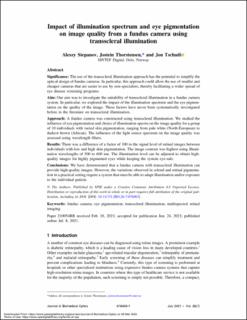| dc.contributor.author | Stepanov, Alexey | |
| dc.contributor.author | Thorstensen, Jostein Bruun | |
| dc.contributor.author | Tschudi, Jon | |
| dc.date.accessioned | 2022-08-30T14:43:25Z | |
| dc.date.available | 2022-08-30T14:43:25Z | |
| dc.date.created | 2021-12-06T12:08:26Z | |
| dc.date.issued | 2021 | |
| dc.identifier.citation | Journal of Biomedical Optics. 2021, 26 (7), 076003. | en_US |
| dc.identifier.issn | 1083-3668 | |
| dc.identifier.uri | https://hdl.handle.net/11250/3014436 | |
| dc.description.abstract | Significance: The use of the transscleral illumination approach has the potential to simplify the optical design of fundus cameras. In particular, this approach could allow the use of smaller and cheaper cameras that are easier to use by non-specialists, thereby facilitating a wider spread of eye disease screening programs.
Aim: Our aim was to investigate the suitability of transscleral illumination in a fundus camera system. In particular, we explored the impact of the illumination spectrum and the eye pigmentation on the quality of the image. These factors have never been systematically investigated before in the literature on transscleral illumination.
Approach: A fundus camera was constructed using transscleral illumination. We studied the influence of eye pigmentation and choice of illumination spectra on the image quality for a group of 10 individuals with varied skin pigmentation, ranging from pale white (North-European) to darkest brown (African). The influence of the light source spectrum on the image quality was assessed using wavelength filters.
Results: There was a difference of a factor of 100 in the signal level of retinal images between individuals with low and high skin pigmentation. The image contrast was highest using illumination wavelengths of 500 to 600 nm. The illumination level can be adjusted to obtain high-quality images for highly pigmented eyes while keeping the system eye-safe.
Conclusions: We have demonstrated that a fundus camera with transscleral illumination can provide high-quality images. However, the variations observed in scleral and retinal pigmentation in a practical setting require a system that must be able to adapt illumination and/or exposure to the individual patient. | en_US |
| dc.language.iso | eng | en_US |
| dc.publisher | SPIE | en_US |
| dc.rights | Navngivelse 4.0 Internasjonal | * |
| dc.rights.uri | http://creativecommons.org/licenses/by/4.0/deed.no | * |
| dc.subject | Fundus camera | en_US |
| dc.subject | Eye pigmentation | en_US |
| dc.subject | Transscleral illumination | en_US |
| dc.subject | Multispectral retinal imaging | en_US |
| dc.title | Impact of illumination spectrum and eye pigmentation on image quality from a fundus camera using transscleral illumination | en_US |
| dc.type | Peer reviewed | en_US |
| dc.type | Journal article | en_US |
| dc.description.version | publishedVersion | en_US |
| dc.rights.holder | © The Authors | en_US |
| dc.source.pagenumber | 14 | en_US |
| dc.source.volume | 26 | en_US |
| dc.source.journal | Journal of Biomedical Optics | en_US |
| dc.source.issue | 7 | en_US |
| dc.identifier.doi | 10.1117/1.JBO.26.7.076003 | |
| dc.identifier.cristin | 1965041 | |
| dc.source.articlenumber | 076003 | en_US |
| cristin.ispublished | true | |
| cristin.fulltext | original | |
| cristin.qualitycode | 2 | |

